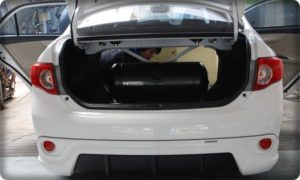Liquefied natural gas vehicles, or LNG cars, use liquefied gas as fuel, one of the cleanest fossil fuels of all. LNG is made by cooling natural gas through a process called liquefaction. The result is a colorless and odorless substance, lighter than water, neither toxic, nor corrosive. Although natural gas is a fossil fuel, it is the least polluting type. By burning LNG, very few greenhouse gasses are released into the atmosphere. That is what makes liquefied natural gas cars a green alternative to traditional vehicles.
Most widely used liquefied natural gas vehicles
Usually, the vehicles that use LNG are public transportation vehicles or heavy duty vehicles, including trucks and buses. Natural gas cars have become increasingly popular due to the rise of gasoline prices. Now, almost every large highway has LNG fueling stations. One reason why heavy duty vehicle owners prefer LNG is the fact that it takes up less storage space than other types of fuels.
There are few small liquefied natural gas vehicles for personal use. One reason is the fact that car manufacturers do not create LNG personal cars. LNG is cost-effective as long as the car is heavily used, because the evaporation rate of the gas is quite high. Personal use cars do not operate for a long enough time to compensate the evaporation losses. That is why LNG is more appropriate for large vehicles that travel long distances.
The benefits of using LNG cars
Natural gas vehicles are more environmentally friendly than other types of cars because they have low greenhouse gas emissions. LNG is also very safe, because it is non-toxic, hardly flammable and non-explosive.
Another great benefit of liquefied natural gas vehicles is the fuel’s low cost. Compared to other diesel fuels, LNG can be produced at a low cost, thus being more affordable. Most LNG used to power vehicles is produced domestically, in the US.
LNG has advantages over other types of green solutions for vehicles, like CNG (compressed natural gas), also. Unlike CNG, liquefied natural gas has a high storage density. Storing the necessary LNG for a large vehicle takes up significantly less space than CNG does.
LNG can be transported to areas where natural gas is not readily available. Because it takes up less volume, it is one of the most cost-efficient solutions available.
Liquefied natural gas vehicles drawbacks
LNG is a viable solution only for cars that travel high mileages, because of the high boil off rate of the gas. However, for large vehicles, LNG is the cleanest and most cost-effective fuel available nowadays.
LNG vehicles have many advantages on diesel cars, going beyond the low cost of the fuel. Thanks to their low gas emissions, LNG cars are an effective green solution. Statistics show that the greenhouse gas emission of LNG trucks is 10% lower than the gas emission of diesel vehicles. If we add the financial savings implied by using LNG, we can understand why liquefied natural gas vehicles are the future of long distance transportation.
[content_band style=”color: #333;” bg_color=”#ffddea” border=”all” inner_container=”true”] [custom_headline style=”margin-top: 0;” level=”h3″ looks_like=”h3″]Main Article[/custom_headline]- Alternative Fuels Vehicles – Types and Advantages

